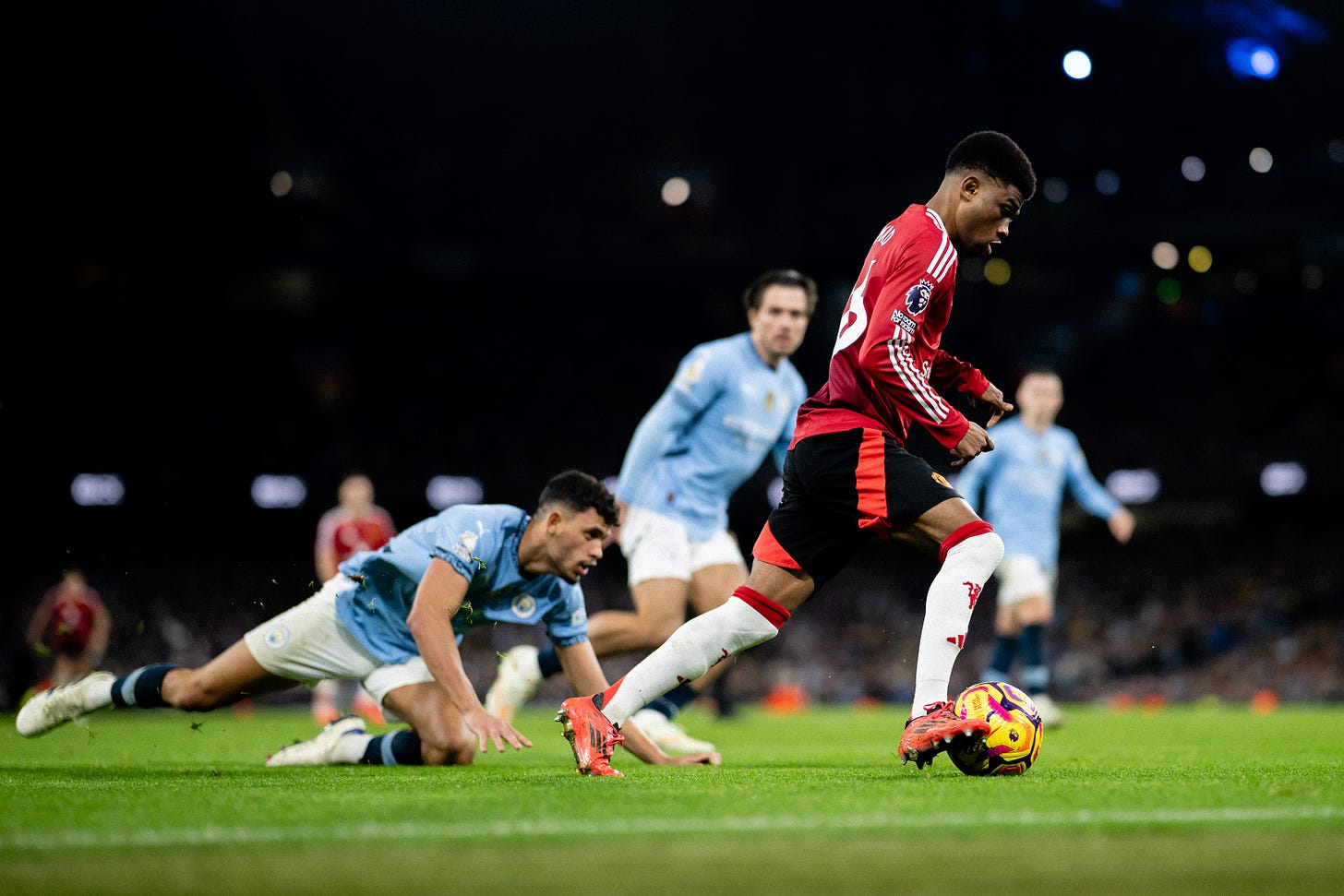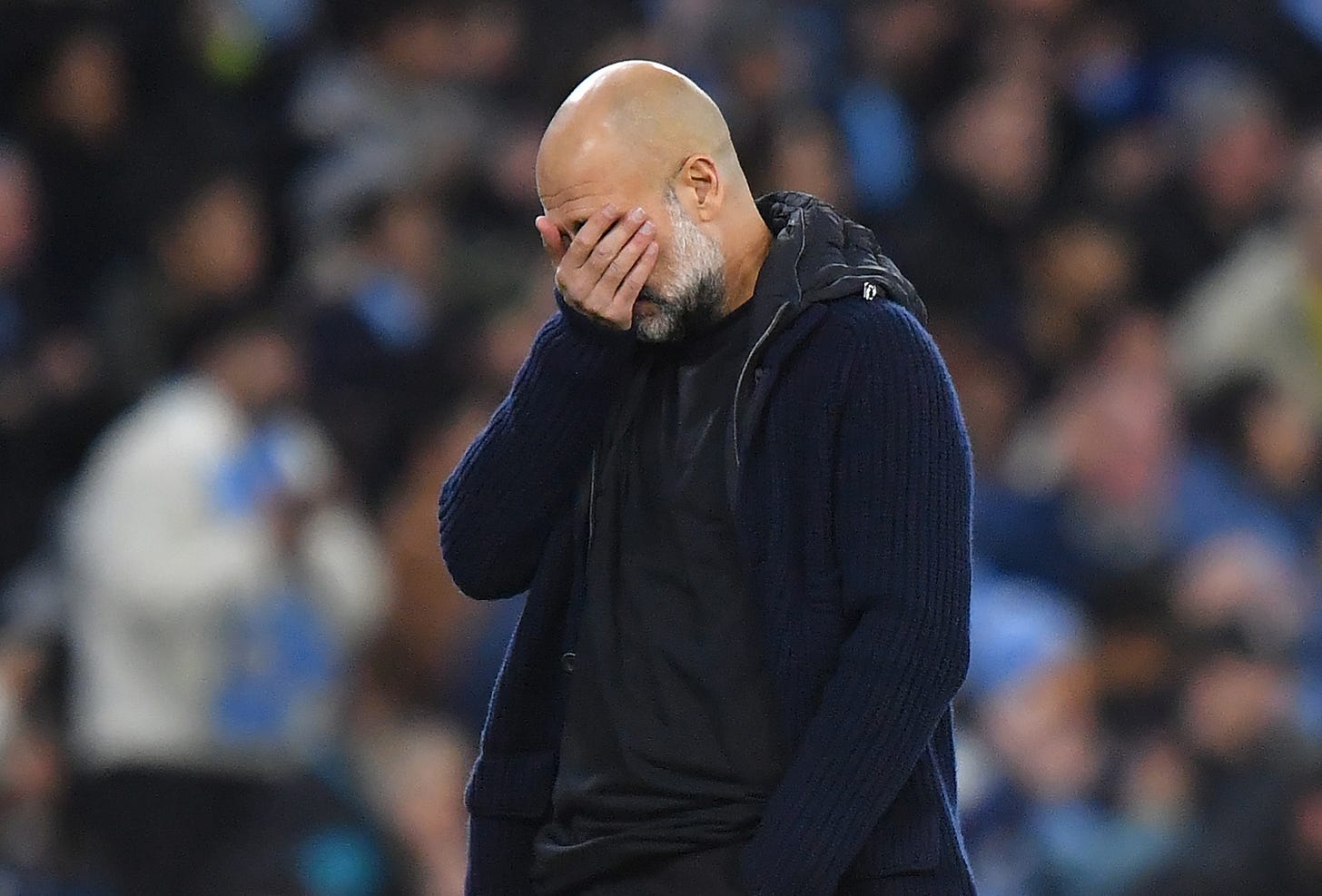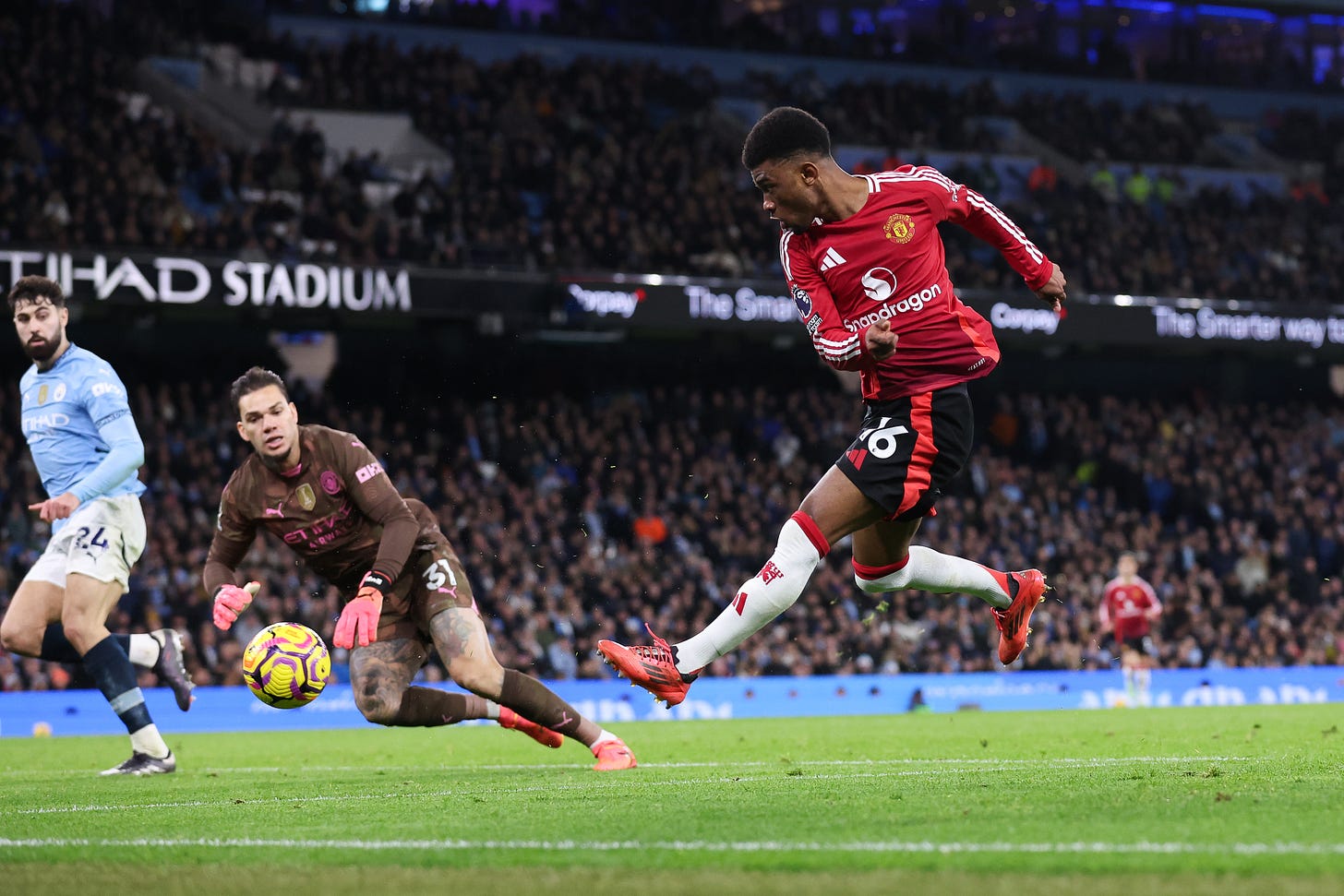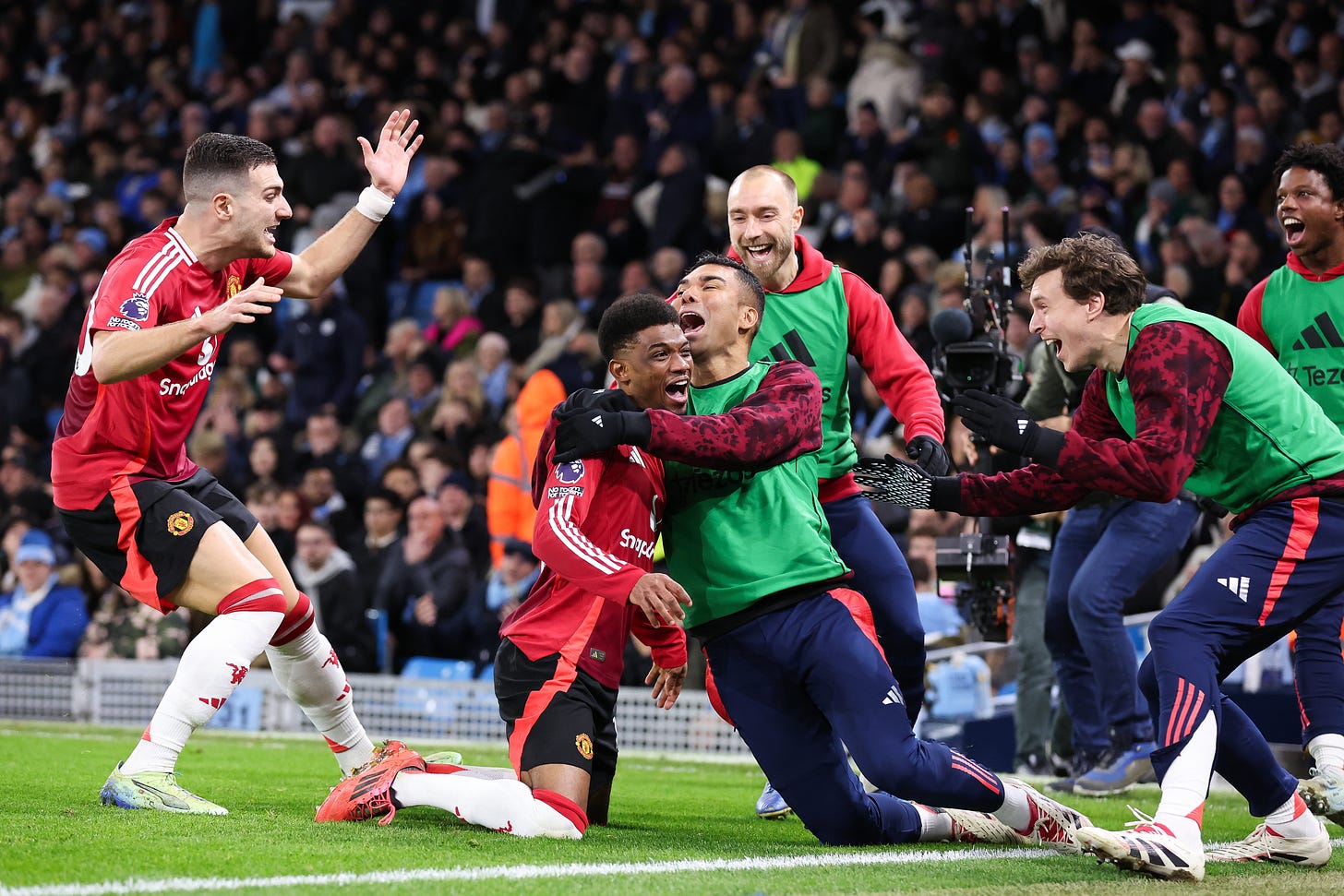The Ballad of Amad Diallo
Manchester United's best attacker is a 22-year-old Ivorian who tore Man City apart on Sunday. He's got the ingredients to be a top-class player.
When Amad Diallo tip-toed in behind the Manchester City backline down the inside channel after 25 minutes, it was another sign that Manchester United manager Ruben Amorim’s 3-4-2-1 formation could prosper against the downright disheveled Sky Blues. The young ex-winger ultimately dragged his shot wide and was ruled offside, but in his new inside-forward role, a throwback—at least in name—to English football’s Middle Ages, he would soon cause all kinds of problems for Pep Guardiola’s outfit. Injuries in defensive areas have been killer, but the space in between the City midfield and defense—particularly in those inside channels—was too often abundant. Add in the lack of pace among City’s defenders, and you’ve got a cocktail that floored the Citizens before the 90 minutes were done.
Because it wasn’t just Amad. The nature of Amorim’s system is that it encourages players in every line to step forward, to step into their duels and send the play rolling in the other direction in one decisive movement. In the contemporary era of transition football, it’s a difference-maker. And against this City side that looks old and static, lacking in dynamism and pace in a way exemplified by the agéd Kyle Walker, it would ultimately prove fatal. The goal that the hosts scored to go 1-0 up ultimately just looked fortuitous, a randomly deflected cross, as they rarely threatened with anything beyond a half-chance before getting run over entirely in the closing stages.
Amad, the young Ivorian, was at the heart of it. It’s not news to United fans that he is their most powerful weapon, particularly in this new system, and at some point he just started exploding through the City lines to cause trouble. In the 60th minute, he picked the ball up with wingback Noussair Mazraoui flanking him, demanding some of Matheus Nunes’s attention, and even with Phil Foden tracking back in support, City’s makeshift left-back was in trouble. Amad engaged the rocket boosters and zipped between the two of them, putting just a bit too much on the touch so that Joško Gvardiol could step in and cut it out. But it was a preview of coming attractions.
After 73 minutes, Mazraoui stepped forward to win the ball off Jérémy Doku at the halfway line and went barreling forward, finding Rasmus Højlund on the turn. The #9 slid a through ball between Gvardiol and Rúben Dias in City’s bedraggled defensive line for Bruno Fernandes to scamper onto. United’s most accomplished technician flicked his chip wide, however, and I began to wonder whether the Red Devils’ superior shape and physicality would be betrayed by their finishing.
But time and again, Amad got in on that back line—and often left them for dead. He dropped his shoulder at one point and left Dias floored. After 80 minutes, he squared up Nunes and skinned him again with a couple of back-and-forth touches and a body feint, leaving him on the ground in the 18-yard box as the Ivorian popped towards the byline. Again he was thwarted by his own meaty touch and a Gvardiol intervention.
But then came the crowning mistake from Nunes, deployed as a hapless defender in a Guardiola anti-masterstroke. The Portuguese, now stationed in the right-back area near the touchline, played a horrifying backpass towards Ederson in goal. He only found Amad. The #16 in red latched onto it in an instant, drifting out to the edge of the box. The goalkeeper squared up to him, trying to contain the threat, and as Mr. Diallo drifted towards him and into the box on the dribble, Nunes came steaming in and fouled him. Penalty.
The whole passage reeked of desperation, disorder, everything we’ve come not to expect from Pep Guardiola’s side. But this seems a different Guardiola side now, exposed in between the lines and in behind over and over again, and this time they were truly punished. Fernandes slotted the penalty away with minimal fuss, 1-1, and the dramatic reversal had only just begun.
A minute later, United were back on the ball with Lisandro Martínez just behind the halfway line. There was a chasm of space between City’s midfield four and the four behind them—a back four at four different depths and with still more chasms between them. It was a shambles, and Amad, lurking in the acres of space on the far side, darted past Nunes into that inside channel again. Such was the Sky Blue disarray that he had time to bend his run behind Gvardiol, who’d fallen asleep.
Amad turned vertical again, comfortably onside by a couple of yards, and Martínez’s barely-diagonal ball—it was almost a straight long ball in behind—erased the City defenders from the play. It hit the turf inside the box and Amad caught it on the half-bounce, still traveling at break-neck pace, popping it up over Ederson before skipping after it and pawing the ball towards goal with a left-footed volley. It rolled almost in slow motion towards the goal line, trundling across the goalmouth. But somehow Gvardiol, jogging back at half-pace to intervene, could not sort his feet out and it nutmegged him.
It was a comedy of errors, starting with the shabby back line with no pressure on the ball. City threw this game away, to be sure. But it was a shining moment, still, for the 22-year-old who has come to life under this new manager and within his intriguing new system. Time and again, Amad would erupt past a Sky Blue shirt or two who were stuck in the mud. He detonated down the sideline at one point, burning the fullback and carrying the ball at breakneck speed before unleashing a scything cross that left the City defenders helpless, saved only by the lack of a United shirt crashing the back post. It was unreal technique, on the run and in stride. Unstoppable.
It was all in marked contrast to the residents of City’s attacking midfield, that area behind Erling Haaland where the magic’s meant to happen. I’ve had questions for years now about Doku’s end product, and whether—not unlike, say, Gabriel Martinelli—he often floats a cross to back-post no-man’s land or slips a cutback to nobody in particular. But at least he can shift and leave a defender in his wake. Jack Grealish came on and was completely anonymous yet again. Phil Foden played the entire match and was essentially limited to some potshots from in and around the top of the box. Even Savinho, who’s looked dangerous in his first season in Manchester despite his lack of goal output, offered nothing after coming on.
In truth, Amad’s showing was in marked contrast to United’s other attackers, too. Marcus Rashford and Alejandro Garnacho were dropped from the squad for this one, in case you hadn’t heard, and their futures at Old Trafford do not currently look bright. Rashford’s had a couple of moments in recent weeks as part of his customary New Manager Bounce, but it’s a long time since he was regarded as a present or future top-class player. Mason Mount went off injured again, and it’s not clear what position he’s suited for in the first place. Fernandes is sliding deeper into midfield in Amorim’s system.
When it comes to those two inside-forward creators, Amad Diallo is the pick of the bunch, a youngster bursting with confidence who can shift through the gears, leave defenders roasted on a spit, and find the finishing touch when it matters. Speed, technique, and composure is a dangerous combination. It’s not just that he’s United’s best attacker at the moment. He may be their only player in forward areas who looks like he could become a genuine top-class player.⚽︎






